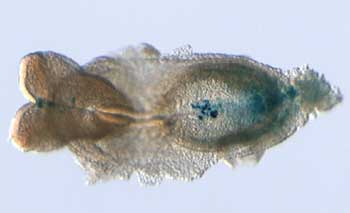| RIKEN Center for
Developmental Biology (CDB) 2-2-3 Minatojima minamimachi, Chuo-ku, Kobe 650-0047, Japan |
| Tead Start: Activation of the Foxa2 enhancer in the node | ||
October 26, 2005 –The great diversity of vertebrate forms is the result of developmental processes that shape the body as it grows, an intricately orchestrated activity that relies on signals from centers within the embryo capable of directing tissue movement and differentiation. Perhaps the best known of these signaling centers is the “organizer,” first identified by Hans Spemann and Hilde Mangold in the newt as a region capable of directing neighboring tissues to adopt specific fates. Studies in other organisms including frog, chick and mouse have shown that organizing centers in these species all share certain properties and characteristics as they guide the embryo through gastrulation, in which it sorts itself into three germ layers. Perhaps even more interestingly, many organizers themselves comprise a diverse and dynamic assembly of cells, marked by specific patterns of gene expression and playing a continuously changing series of roles as the embryo matures.
In the mouse, the organizer forms at the anterior end of a structure known as the primitive streak about six and a half days after conception. Throughout embryogenesis, the organizer plays home to a number of cell populations, first coordinating the emergence of the head before assuming a new identity as the “node,” which regulates trunk development beginning at about embryonic day 7. The node remains a morphologically distinct region thereafter, and contains cells that serve as the progenitors of the notochord, a rod-like stretch of mesoderm that underlies the nascent central nervous system along the midline of the body and itself serves as a signaling center regulating the dorsoventral patterning of the trunk. It is characterized by the expression of a number of node-specific molecules, one of the most significant of which is Foxa2, a transcription factor known to regulate the development of other midline signaling centers as well. Given its prevalence and importance in organizing the embryonic midline in all taxa studied, the question of the regulation of Foxa2 expression is one of widespread interest to developmental biologists. Now, in an article published in the November issue of Development, the Laboratory for Embryonic Induction (Team Leader, Hiroshi Sasaki)and colleagues in the CDB and Osaka University report an advance in the understanding of how Foxa2 gene expression is driven in the node. Building on previous knowledge of a Foxa2 enhancer specific to the node and notochord, the team made transgenic mice in which a core-element sequence containing a motif critical to the enhancer’s activity was used to drive the expression of β-galactosidase, enabling them indirectly to track Foxa2 activation over space and time. Equipped with a monitor of enhancer activity, they studied patterns of expression in the embryo and noticed an intriguing similarity to the footprint of Wnt/ β-catenin, a molecular pathway involved in many aspects of cell signaling and differentiation. Co-transfection of canonical Wnt factors with the core element (CE) into embryonic carcinoma cells revealed that Wnt does act upstream of the Foxa2 enhancer, albeit in an indirect manner. Looking at the CE more closely, Sasaki et al found that its function relies on a pair of three-nucleotide regions in its 27-base sequence, suggesting that the cooperation of two transcription factors is essential for the enhancer’s ability to activate Foxa2 expression in the node. Now curious, they used the CE sequence as bait in a yeast one-hybrid screening against a mouse cDNA library, intended to isolate factors that interact with the core element. A pair of members of the TEAD family of transcription factors turned up in many of the positive clones. Tead genes and their cofactor Yap65 are expressed widely in the embryo during the E6.5 to E8.5 stages, including in regions of Foxa2 activity, marking them as promising candidates for further study, which was borne out by transfection of members of the Tead family and the Yap65 cofactor into carcinoma cells. All four Tead factors appear to be involved in the regulation of the Foxa2 enhancer core element, although at varying intensities, with Tead1 and Tead4 showing the strongest activity. Importantly, this Tead effect was found to be independent of the Wnt/β-catenin pathway, whose precise molecular nature remains unknown but is thought to be linked to the CE 5′ region. Looking next in vivo, they electroporated a repressor form of Tead into transgenic mouse embryos and found that interference with Tead function disturbed both Foxa2 expression and the normal development of the notochord. Parallel studies in zebrafish showed that Tead proteins regulate foxa2 in the embryonic shield, an organizer with similar function to the mouse node, in fish as well.
|
||
|
||
[ Contact ] Douglas Sipp : sipp@cdb.riken.jp TEL : +81-78-306-3043 RIKEN CDB, Office for Science Communications and International Affairs |
| Copyright (C) CENTER FOR DEVELOPMENTAL BIOLOGY All rights reserved. |
